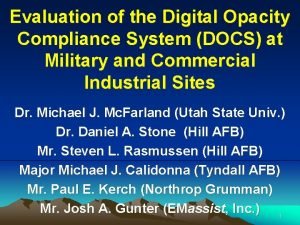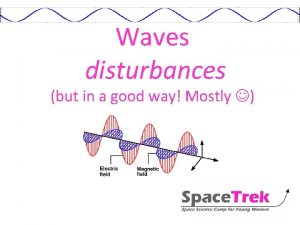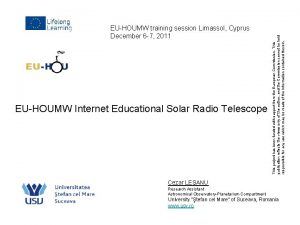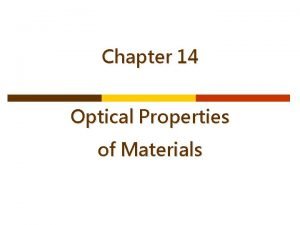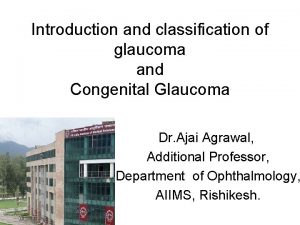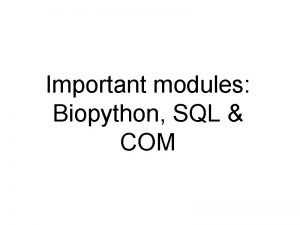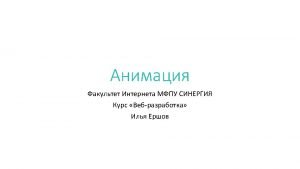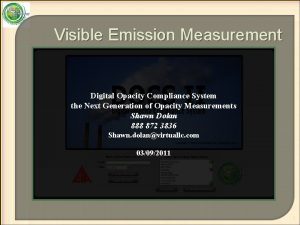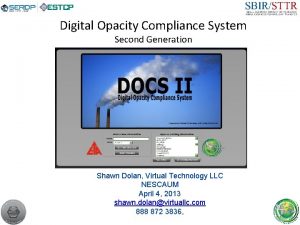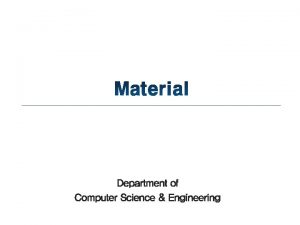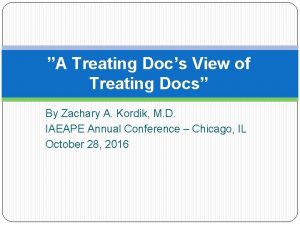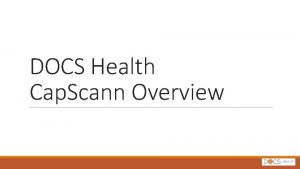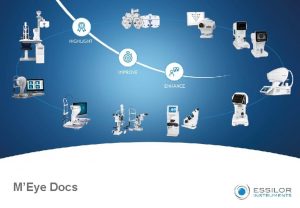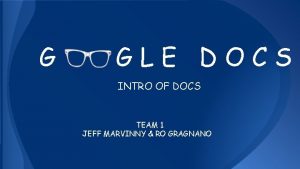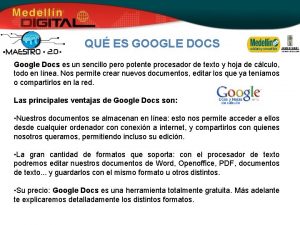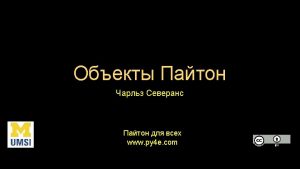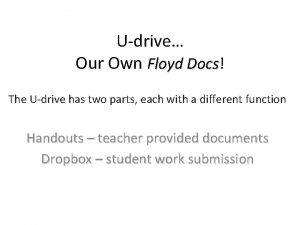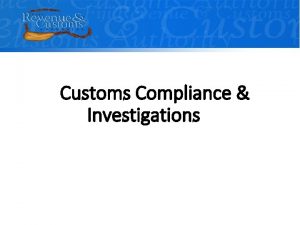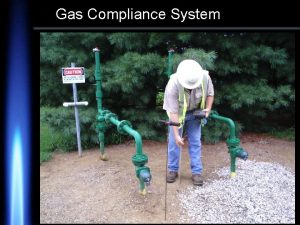Evaluation of the Digital Opacity Compliance System DOCS


































- Slides: 34

Evaluation of the Digital Opacity Compliance System (DOCS) at Military and Commercial Industrial Sites Dr. Michael J. Mc. Farland (Utah State Univ. ) Dr. Daniel A. Stone (Hill AFB) Mr. Steven L. Rasmussen (Hill AFB) Major Michael J. Calidonna (Tyndall AFB) Mr. Paul E. Kerch (Northrop Grumman) Mr. Josh A. Gunter (EMassist, Inc. ) 1

Funding for this effort was furnished by the Environmental Security Technology Certification Program (ESTCP) under contract number CP 200119. 2

Participants in the DOCS Technical Evaluation Program • USEPA Emissions Measurement Center (RTP, NC) • USEPA – Region 6 (Dallas, TX) • Tyndall AFB (Panama City, FL) • Wright Paterson AFB (Dayton, Ohio) • Hill AFB (Ogden, UT) • Eastern Technical Associates (Raleigh, NC) • Scientech Inc. (Layton, UT) 3

OUTLINE • Study Objectives • Basic Operation of the Digital Opacity Compliance System • Criteria for establishing Method 9 Equivalency • Summary of data collected at field sites • Conclusions 4

Study Objectives • Verify that the technical principles that underlie the DOCS technology are based on sound science • Determine if the accuracy of DOCS in measuring opacity is statistically equivalent to EPA Reference Method 9 • Compare the performance of DOCS relative to EPA certified smoke readers 5

Evaluation of the DOCS at EPA Approved Method 9 Smoke Schools • September 2001 – Ogden, UT • December 2001 – Augusta, GA • March 2002 – Columbus, OH 6

7

Criteria for Establishing Equivalency with EPA Method 9 ÷ DOCS – transmissometer ÷ £ 7. 5% At the 99% confidence level 8

Ogden, UT Smoke School Weather Conditions Mean Temperature ( F) Day 1 66. 2 Day 2 60. 8 Day 3 60. 8 Average Wind Speed (mph) 8. 9 9. 7 8. 1 Sky Conditions Clear Relative Humidity (percent) 27. 2 45. 2 30. 5 Precipitation (in. ) 0 0 0 Vertical Sun Angle (degrees) 42. 2 39. 4 38. 5 9

10

N DOCS Field Positioning STACK Stack Height – 15 Feet 70 degrees Stack Distance – 50 feet C 4 C 3 70 degrees C 1 70 degrees C 2 70 degrees 11

DOCS Results from Ogden, UT EPA Approved Smoke School Color of Smoke Opacity Range Ave. Dev. No. of Samples Black 0 – 40% 5. 4 1745 4. 9 - 5. 8 White 0 – 40% 5. 9 1686 5. 4 – 6. 3 99 % CI 12

August, Ga. EPA Approved Method 9 Smoke School 13

14

15

Columbus, Ohio EPA Approved Method 9 Smoke School 16

17

For all opacity ranges evaluated in Ohio, neither the DOCS nor Method 9 Certified Human Observers were able to achieve the Method 9 Accuracy Standard 18

Differences Between UT, GA and OH Smoke School Results • With relatively short stack heights (15 feet), human observers can employ background other than sky • The DOCS is limited to only using sky as background and is therefore highly dependent on weather conditions. 19

Field Deployment of DOCS at Military and Commercial Sites • Four (4) commercial-of-the-shelf (COTS) digital cameras were utilized • DOCS camera operators were allowed to position themselves in any valid Method 9 location relative to the stack 20

Field Deployment of DOCS at Military and Commercial Sites • Waste incinerator in Anchorage, AK • EPA-approved smoke generator in Anchorage, AK • Coal-fired power plant in Healy, AK • Coal fired boiler at Eielson AFB, AK • Diesel-fired pump station in Fairbanks, AK 21

Only the EPA-approved smoke generator in Anchorage, AK and the coal-fired power plant in Healy, AK, were equipped with continuous opacity monitors (COM). 22

Coal Fired Power Plant – Healy, AK 23

Average Weather Conditions at Alaska Field Sites Anchorage, AK Mean Temperature ( F) 54. 0 Healy, AK 41. 9 Average Wind Speed (mph) 4. 5 1. 2 Sky Conditions Rain Overcast Mist Overcast Relative Humidity (%) 100. 0 96% Precipitation (in. ) 0. 82 0. 00 Vertical Sun Angle (º) no sun 24

Results from Systems Equipped with Continuous Opacity Monitors (COM) Opacity Measurement Opacity Approach Range DOCS: COM Ave. Dev. 0 – 100% 14. 1 Observer: COM 0 – 100% 6. 0 Sample No. 99% CI 215 11. 6 – 16. 6 224 5. 2 – 6. 8 25

Results from Facilities Equipped with COM • Method 9 certified readers appeared to generate opacity readings that were more consistent with the COM opacity readings • Results were not surprising given the response of DOCS during overcast weather conditions encountered during smoke school field tests 26

Waste Incinerator – Anchorage, AK 27

Results from Systems Not Equipped With Continuous Opacity Monitors (COM) Opacity Measurement Approach Max. Opacity Ave. Dev. Sample No. 99% CI DOCS: Observer 100% 10. 5 360 8. 9 – 12. 2 DOCS: Observer 40% 5. 0 255 3. 7 – 6. 3 28

Results from Systems Not Equipped with Continuous Opacity Monitors (COM) • Over the full range of opacity evaluated, on average, the difference between the DOCS and certified human observers was approximately 10. 5 %. • Over an opacity range of 0 to 40%, the DOCS consistently reported opacity readings that were, on average, within 5% of those reported by Method-9 -certified human observers 29

CONCLUSIONS 30

CONCLUSIONS • The use of human observers to quantify opacity is inherently subjective • With increasing public pressure to reduce airborne particulate matter, there is a clear need to increase in both the accuracy and reproducibility of the methods employed to verify the level of visible opacity 31

CONCLUSIONS • The DOCS technology can accurately and reliably measure the opacity of smoke plumes when weather conditions provide optimum color contrast between plume and background • During DOCS field deployment at the military and industrial facilities, climatic conditions were characterized by light rain and overcast skies, which are unfavorable for utilization of the DOCS 32

CONCLUSIONS • Over an opacity range of 0 to 40%, the DOCS consistently reported opacity readings that were, on average, within 5% of those reported by Method-9 -certified human observers • The conservative response of the DOCS is a potentially useful characteristic of the technology particularly for those facilities that desire to establish a reliable margin of safety in complying with regulated opacity levels 33

QUESTIONS? 34
 Compliance opacity monitoring
Compliance opacity monitoring Atmospheric opacity
Atmospheric opacity Atmospheric opacity
Atmospheric opacity Opacity and translucency in insulators
Opacity and translucency in insulators Line opacity
Line opacity Modal opacity
Modal opacity Trabeculodysgenesis meaning
Trabeculodysgenesis meaning Python turtle opacity
Python turtle opacity Transition keyframe
Transition keyframe Icis plugin
Icis plugin Hình ảnh bộ gõ cơ thể búng tay
Hình ảnh bộ gõ cơ thể búng tay Slidetodoc
Slidetodoc Bổ thể
Bổ thể Tỉ lệ cơ thể trẻ em
Tỉ lệ cơ thể trẻ em Voi kéo gỗ như thế nào
Voi kéo gỗ như thế nào Tư thế worms-breton
Tư thế worms-breton Chúa yêu trần thế
Chúa yêu trần thế Môn thể thao bắt đầu bằng từ đua
Môn thể thao bắt đầu bằng từ đua Thế nào là hệ số cao nhất
Thế nào là hệ số cao nhất Các châu lục và đại dương trên thế giới
Các châu lục và đại dương trên thế giới Công của trọng lực
Công của trọng lực Trời xanh đây là của chúng ta thể thơ
Trời xanh đây là của chúng ta thể thơ Mật thư anh em như thể tay chân
Mật thư anh em như thể tay chân Làm thế nào để 102-1=99
Làm thế nào để 102-1=99 độ dài liên kết
độ dài liên kết Các châu lục và đại dương trên thế giới
Các châu lục và đại dương trên thế giới Thơ thất ngôn tứ tuyệt đường luật
Thơ thất ngôn tứ tuyệt đường luật Quá trình desamine hóa có thể tạo ra
Quá trình desamine hóa có thể tạo ra Một số thể thơ truyền thống
Một số thể thơ truyền thống Bàn tay mà dây bẩn
Bàn tay mà dây bẩn Vẽ hình chiếu vuông góc của vật thể sau
Vẽ hình chiếu vuông góc của vật thể sau Thế nào là sự mỏi cơ
Thế nào là sự mỏi cơ đặc điểm cơ thể của người tối cổ
đặc điểm cơ thể của người tối cổ Giọng cùng tên là
Giọng cùng tên là Vẽ hình chiếu đứng bằng cạnh của vật thể
Vẽ hình chiếu đứng bằng cạnh của vật thể
